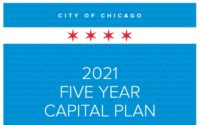The federally-established regional planning commission for seven counties around Chicago has unveiled its 30-year plan for developing the region.
Randall S. Blankenhorn, executive director of the Chicago Metropolitan Agency for Planning, says it is �the first comprehensive plan for developing Chicago in the century since Daniel Burnham brought out his legendary Plan of Chicago.� The goal of CMAP�s GO TO 2040 plan is to guide development of seven counties in northeastern Illinois�Cook, DuPage, Kane, Kendall, Lake, McHenry, and Will�with a coordinated regional effort.
The region�s seven counties contain 284 municipalities in the metropolitan Chicago area.
�The metropolitan area currently has a population of about eight million and two million more people will live here by 2040,� says CMAP spokesman Tom Garritano. �The GO TO 2040 plan aims to guide development in a way that provides livable communities and makes best use of the resources we have.�
The comprehensive plan addresses virtually all aspects of community growth, from housing and transportation, to education, business innovation, tax reform and coordinated government.
�We need to think about how this whole area develops,� Blankenhorn says. �CMAP�s role is to guide, provide expert advice and coordinate. All the final decisions still rest with local governments.�
He says the group, created in 2007, tries to help local governments think about how their decisions impact others in the region and to work together for optimum solutions.
The plan focuses on livable communities, regional mobility, human capital and efficient governance.
It emphasizes modernization instead of expansion and encourages more compact, sustainable development patterns.
That includes things like improved roadways, public transit, preservation of open space, redevelopment of existing space, and reducing consumption of energy and water.
�There will be some greenfield development,� says Blankenhorn. �But we want to look first to redeveloping what we have.�
The plan estimates that more than 100,000 acres of vacant or underutilized commercial and industrial land is available for redevelopment within municipal boundaries.
GO TO 2040 proposes to redevelop those properties with a mix of residential and non-residential uses.
The plan estimates that redeveloping those properties could accommodate about 1.2 million people, or about half the region�s projected growth over the next 30 years.
�Executing the plan will provide work for architects, engineers and construction companies,� says Blankenhorn.
CMAP�s board and policy committee, consisting of representatives from the involved counties, will vote on the plan in October.
The GO TO 2040 plan and more information about CMAP can be viewed and downloaded at www.goto2040.org


Post a comment to this article
Report Abusive Comment